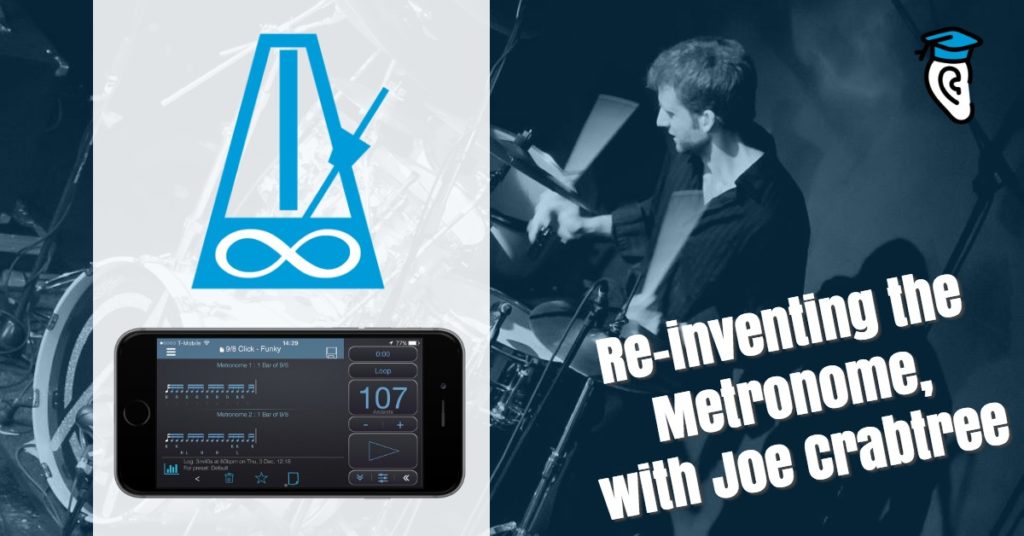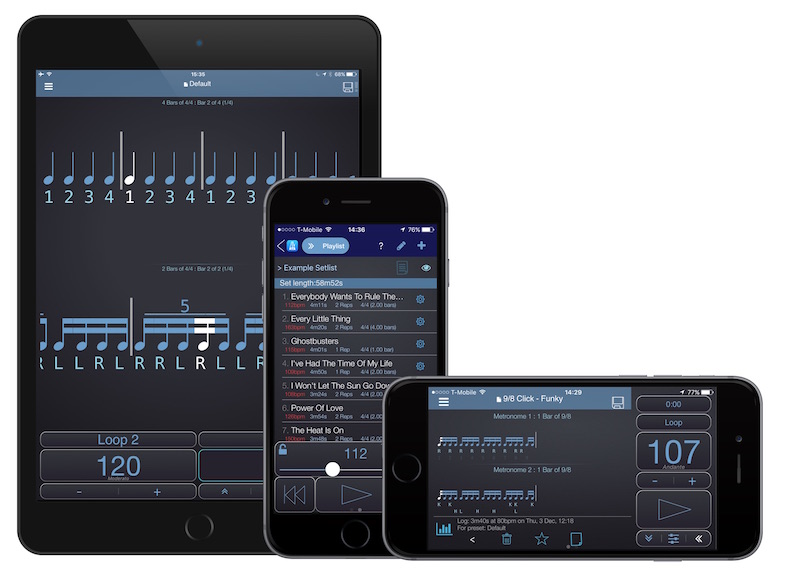We were awed when we recently discovered the way-beyond-the-metronome app, PolyNome. We looked up its creator, drummer Joe Crabtree, and he filled us in on how it all came about and the mind-boggling capabilities of this constantly evolving new tool.
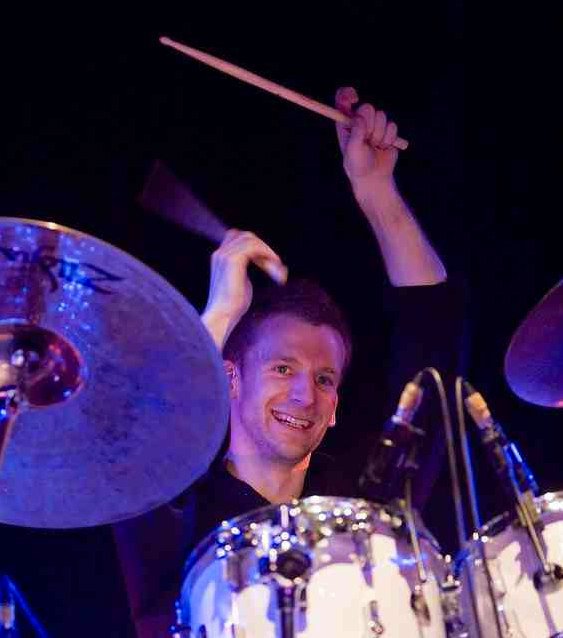 I’ve been playing drums since I was 11. At school I always had more of an interest in the maths and physics side of things than literature. I like logic, puzzles, and the scientific method and I applied those interests when learning the drums. I remember when I was about 14 wondering if it was possible to divide a pulse into three and two at the same time. Figuring out that it was possible and devising a method to calculate how it would sound was my introduction to the world of polyrhythms.
I’ve been playing drums since I was 11. At school I always had more of an interest in the maths and physics side of things than literature. I like logic, puzzles, and the scientific method and I applied those interests when learning the drums. I remember when I was about 14 wondering if it was possible to divide a pulse into three and two at the same time. Figuring out that it was possible and devising a method to calculate how it would sound was my introduction to the world of polyrhythms.
At university I studied physics and was forced to do a computer programming module. I had little interest in it at the time, but it turned out to be very useful later on. When I had the initial PolyNome idea I didn’t have a clue how to write iPhone Apps. I emailed Lucas Ives after he signed up for lessons on my website.

I found out that he lived in New York, had worked for Pixar, and was Dave Weckl’s drum tech. We met the next time I was in New York and I told him my idea for PolyNome.
I’d already written software for Mac/PC which did what I wanted PolyNome to do—I just didn’t know where to start writing an iPhone version. Between us we got PolyNome version 1 in the App Store sometime in 2011.
Later on I had many ideas for features to add. Lucas had got very busy with a new job, moving house, getting married, etc. and didn’t have time to work on it. I had the summer off from touring so decided to watch some lectures on iTunes U, read a few books, and learn how to do it myself. I began adding features.
At first I barely knew what I was doing, but after a few months of investing all my spare time in it I began to get comfortable writing in Objective C (the language of iPhone apps). I spent nearly every waking hour over the next two years re-writing it from the ground up to create PolyNome version 2.
Initially I wanted a piece of software that would allow me to hear how the table of time sounded when played accurately. The table of time is where you gradually increase the subdivisions that you’re playing from whole notes, to half note triplets, to half notes, then quarter note triplets, etc. A regular metronome just keeps the pulse – I wanted something that you could program rate changes into.
To be honest, it might have been a mistake to call PolyNome a ‘metronome’. It’s really more of a Programmable Drum Machine / Practice Routine Creator / Practice Log / Set List Creator.
Firstly, it’s rock solid. It’s surprisingly difficult to write an iOS app that plays sounds at precise times. PolyNome is sample accurate. It’s literally impossible to have a more accurate metronome for iOS.
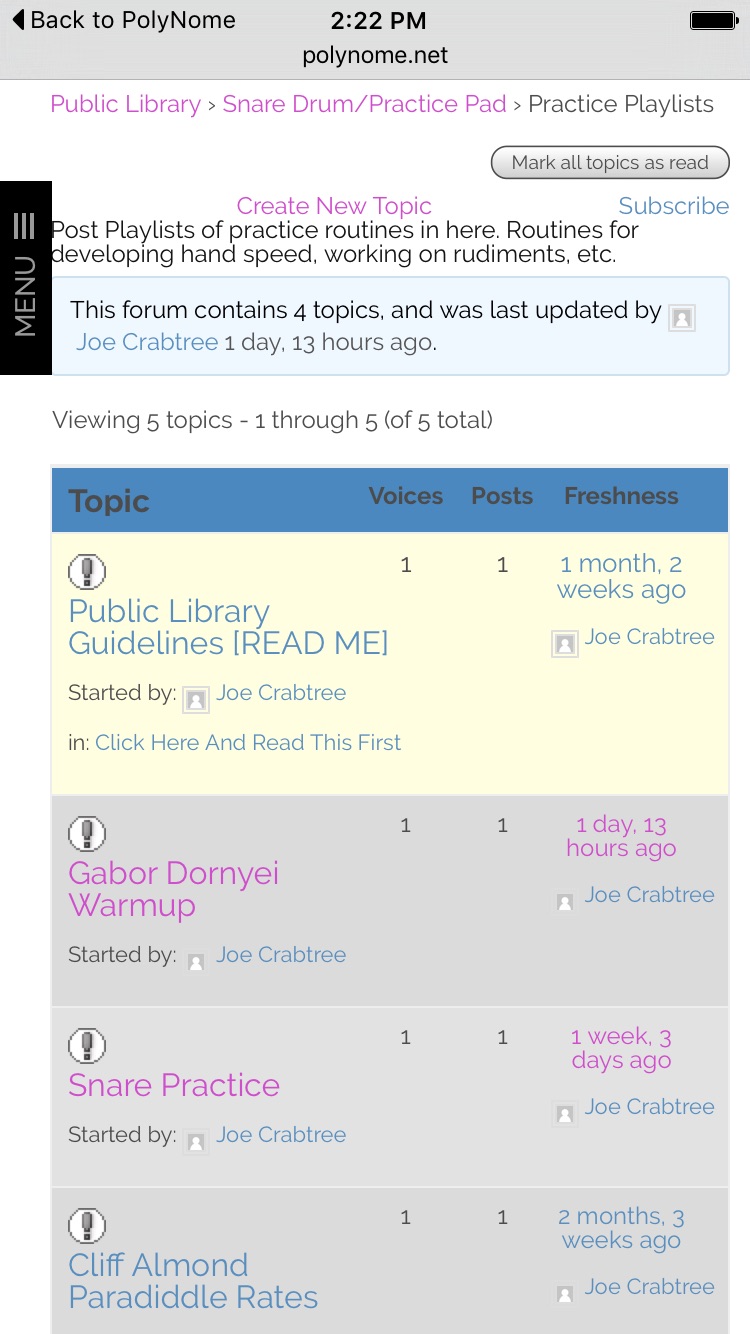 As mentioned before, it’s a lot more than a metronome. You can program full drum and percussion grooves. You can program any rhythmic idea you might have—including things using quintuplets, septuplets, or any other division of a note.
As mentioned before, it’s a lot more than a metronome. You can program full drum and percussion grooves. You can program any rhythmic idea you might have—including things using quintuplets, septuplets, or any other division of a note.
The Pro version has advanced voice counting features, a Practice Log and Playlists.
Playlists allow you to line up Presets one after another to create full song structures, time and tempo changes, and more.
The short answer is that it does everything I ever wanted a metronome to do and more. Every time I think of something I wish it did I go back to the computer and add that feature.
One of the more recent additions is the PolyNome Public Library. This is a resource where PolyNome users can upload Presets and Playlists that they’ve created and download creations of other users. So you never actually have to program it at all—you can just browse the library for things that look interesting to you. I’ve already been inspired by what users are uploading.
I do. I think practice with a metronome is very important for drummers. It’s so easy to think you’re keeping steady time when in fact you’re speeding up or slowing down. This is especially true when playing complex grooves or adding fills to simple grooves. The idea behind the Practice Log came from the concept of working on a groove at different tempos.
Say, for example, you want to really lock in a new groove. It makes sense to practice it over a range of tempos – eg. 100 to 150 BPM. In the past I’d tried writing down what I’d worked on and for how long, but it always got messy. I’d end up with note books and little paper charts, but I’m not a tidy person and it seemed inefficient to me.
I originally thought about creating another app to log what I was working on. I decided I’d want to log the name of the exercise, the tempo, the time I’d spent on it, and the date. Then I realised that PolyNome already knows all of these things so it made sense to integrate the log right into PolyNome. If you press play on a Preset called “Paradiddle Practice” and hit stop after five mins – PolyNome adds this to the Practice Log. You can add a note against the practice event to say how you felt, or you can add notes to the Daily Log (like a journal) There’s a Practice Log page where you can view the time you’ve spent practicing against the date:
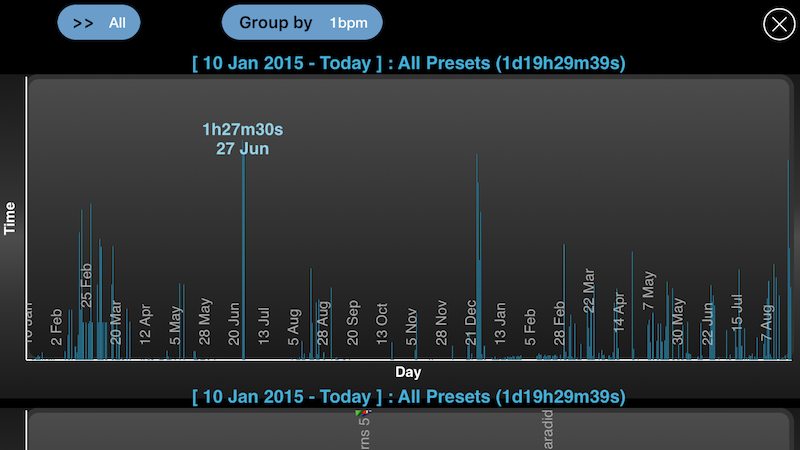
The time you’ve spent practicing each preset:
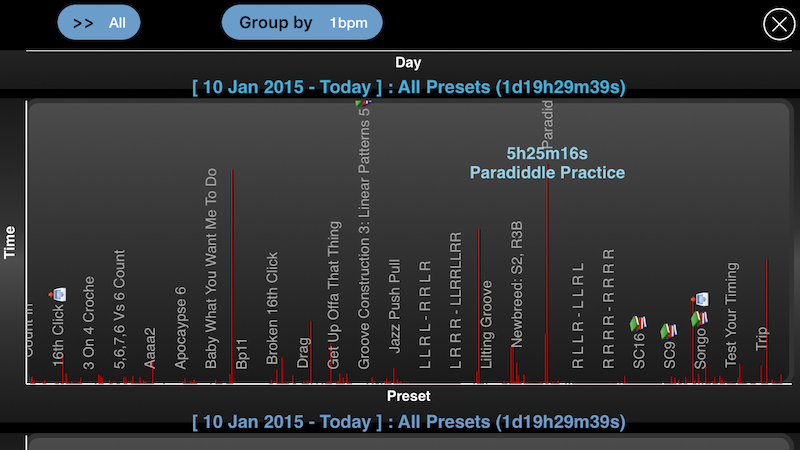
Or the time you’ve spent practicing at each tempo:
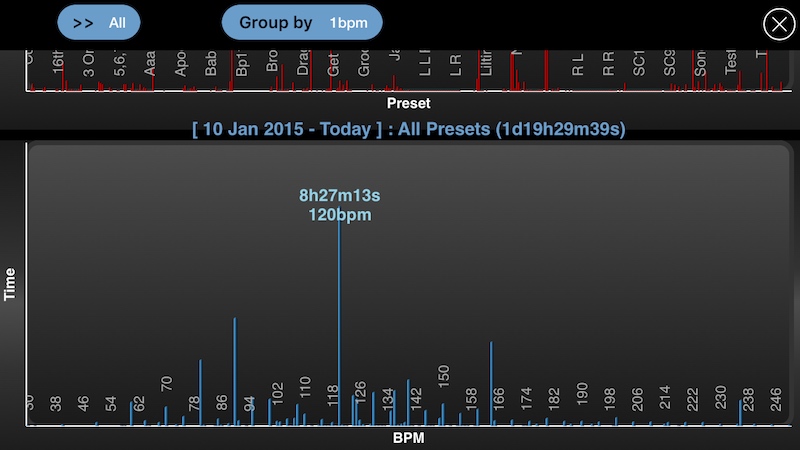
The last one is a great way to guide you towards working on tempos that you tend to ignore.
You can also view and print a PDF which summarizes what you’ve worked on and for how long alongside your Daily Log notes. This is a great way to see how long it took you to reach various goals.
I get many emails from happy PolyNome users. Some of them say it’s helping them learn grooves and fills that had puzzled them for a long time. It’s possible to program in a groove and separate the hi-hat part from the kick and snare. You can slow it down and focus on how each limb interacts with the others. It’s easy to create clicks or grooves with periods of silence.
I get a lot of emails from people saying that this is helping them to improve their timing. It’s surprising how you can feel very comfortable playing to a click, but when it disappears you feel anxious and begin to question your internal time. When the click comes back you get to see whether you had slowed down or rushed ahead.
Other people love that it reminds them when they haven’t practiced for 24 hours (or 2 days, 3 days, etc). It’s helping them to practice more regularly and that simple step is improving their playing.
You can create complex grooves and clicks in PolyNome. The idea of Presets is that you can save your pattern and recall it at a later date without having to program it again. The second reason for Presets is that they give a name to what you’re working on in the Practice Log.
You might have a preset called “Single Stroke Roll” and another called “Paradiddles” which are both just simple quarter note clicks. If you practice your singles with the Single Stroke Roll preset and your Paradiddles with the Paradiddle preset then the Practice Log will show you how long you’ve spent working on those rudiments and which tempos you’ve played them at.
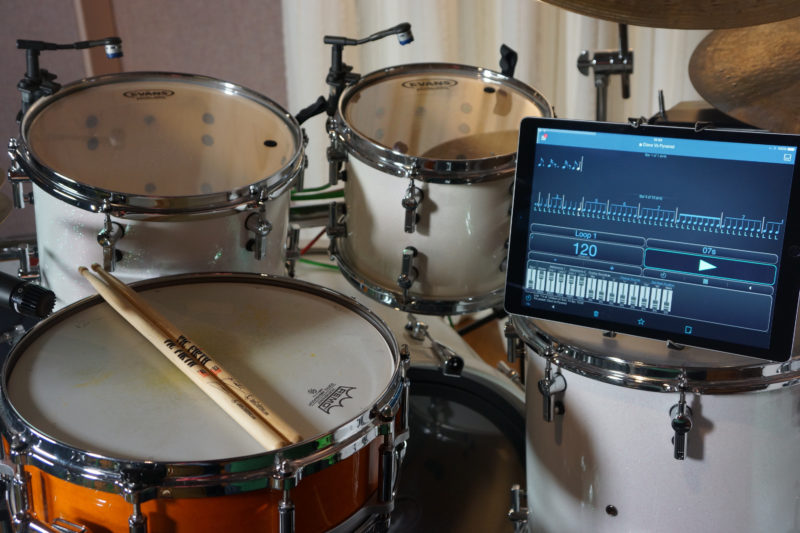
Of course. Anything you can think of can be programmed into PolyNome.
The Public Library is the place to find these. For example, I downloaded a Playlist that someone had created called “Ear Training”. It was a bar with a kick on the quarter note followed by a click on the “and”. Then there were three bars with just the click on the “and”. So you get to practice with a displaced click and every four bars you get the reference of where the actual down beat is.
The Playlist contained Presets with the displaced click being on the “e” and on the “a”. I installed it and had a lot of fun playing with it. I’m sure that over time many more interesting Presets and Playlists will be added to the Library.
I’m now working with Drumhead Magazine to put patterns from their educational articles into PolyNome.
All the time. I spend most of my time writing the code and adding new features so I don’t actually get much chance to use it myself. There’s a lot of irony in the fact that I was doing a lot of practice and that’s what inspired me to come up with the Practice Log feature. I got very excited about being able to log what I was practicing and I thought it would inspire me to practice more.
That was the point that I started learning how to code and since that time I’ve hardly touched a practice pad or drum kit—I’ve become a developer who occasionally plays the drums! But I get emails all the time from people who have come up with new or interesting twists on the way I envisaged it being used.
I have some new ideas on my to-do list, but I like to wait and see how people are using it, and how I use it when I get a bit of time to practice. Most of the features come as a result of me playing with it and thinking “I wish it could do this”. I guess you could say it kind of evolves on its own.
Creators like Joe Crabtree—so open and welcoming to the contributions of their users—give apps like PolyNome a life of their own. Go ahead and give it a try, and who knows? Your ideas may be the next big thing in the growth of the PolyNome app!

